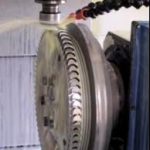The nozzle exit velocity of steam turbines (termed the spouting velocity) is uniquely determined by the steam conditions at the customer’s plant. The optimum turbine blade speed is then a unique fraction of the spouting velocity (about 50 % for impulse and about 25% for Curtis stages). Thus, the optimum turbine blade speed is uniquely determined by the customer’s steam parameters. Blade speed is the product of shaft speed and disk diameter. Thus, the same blade speed can be generated by an infinite number of combinations of shaft speed and disk diameter selected by the turbine designer, as long as the product of the two is equal to the optimum value. High shaft speed results in small rotor size, and vice versa. Turbine diameter is inversely proportional to shaft speed. The flow of steam for incidental power applications is typically 1 – 8 tonnes per hour, very small by conventional turbine standards. This means that the steam flow, to be properly guided, occupies only a portion of the periphery of a large turbine rotor (5 – 20%), and a larger fraction of a small turbine rotor (30 – 100%). This is termed the arc of entry, and larger arcs of entry are essential for higher efficiency. This is because steam within the arc of entry does work on the turbine, while the “dead” steam outside this arc acts as a drag on the turbine, reducing output. Therefore, for small steam flows, it is essential to have a small rotor disk for high efficiency. For a given optimum blade speed, it is therefore advantageous to have the largest shaft speed, for small steam flows.
The maximum shaft speed is determined by technology limitations of rotor material & design, shaft rotor dynamics, and bearing & seal life. ET Group has utilized aerospace materials and technologies to increase the shaft speed from a conventional 3,000 – 3,600 RPM to 12,000 RPM. This enables the use of small rotor disks (typically 300 – 330 mm in diameter), with large arcs of entry (30 – 100%). This, coupled with advanced aerodynamic design, results in efficiency gains of 15 – 30 % over conventional designs.
High speed design allows the use of premium materials enhancing life and safety of equipment
Turbine diameter is inversely proportional to shaft speed. By using higher shaft speeds, the turbine disk is made very small in the ECT. The volume (and weight) of a turbine is proportional to the cube of its size. Thus, by running the ECT at 4 times conventional speed, the turbine size is 1/4th, and turbine weight is about 1/8th of a typical low-speed turbine. A 160 kW ECT turbine + gearbox weighs about 400 kg, compared to 2,500 – 4,000 kg for a comparable low-speed conventional machine. This allows the use of premium materials of construction, such as austenitic stainless steel costing 2-3 times as much as cast iron or low-alloy steel, and still allows competitive pricing.
The advantage of stainless steel is the highly enhanced corrosion and erosion life span.
A second advantage of the use of stainless steel material is found in several process industries where discontinued process heat or power is needed and where the turbine may be shut-down 2 – 3 times per week for extended periods, for various process-related reasons. Conventional cast iron and low-alloy steel construction would suffer significant corrosion due to high temperature and humidity and air infiltration during shut-downs. Further, a lot of the saturated steam boilers used often generate wet steam, which is generally acceptable for the process heating applications. Conventional (non-stainless-steel) turbines would quickly deteriorate and erode under these steam conditions. Thus, the corrosion/erosion life of the ECT will be at least an order of magnitude greater than conventional turbines, and this is derived from its high-speed small dimensions design!
Containment is the ability of turbine housings to retain fragments of blades or disks that separate from the turbine rotor due to foreign-object damage, or other catastrophic events. Austenitic stainless steel is recognized as the best material for ballistic protection, as it has an elongation of greater than 50% before rupture, and thus can absorb huge amounts of kinetic energy before failure. This makes our turbines capable of fully containing any catastrophic turbine blade or rotor failure that might occur over the long design life of the turbine. This is a unique capability, unmatched by any other turbine equipment.
